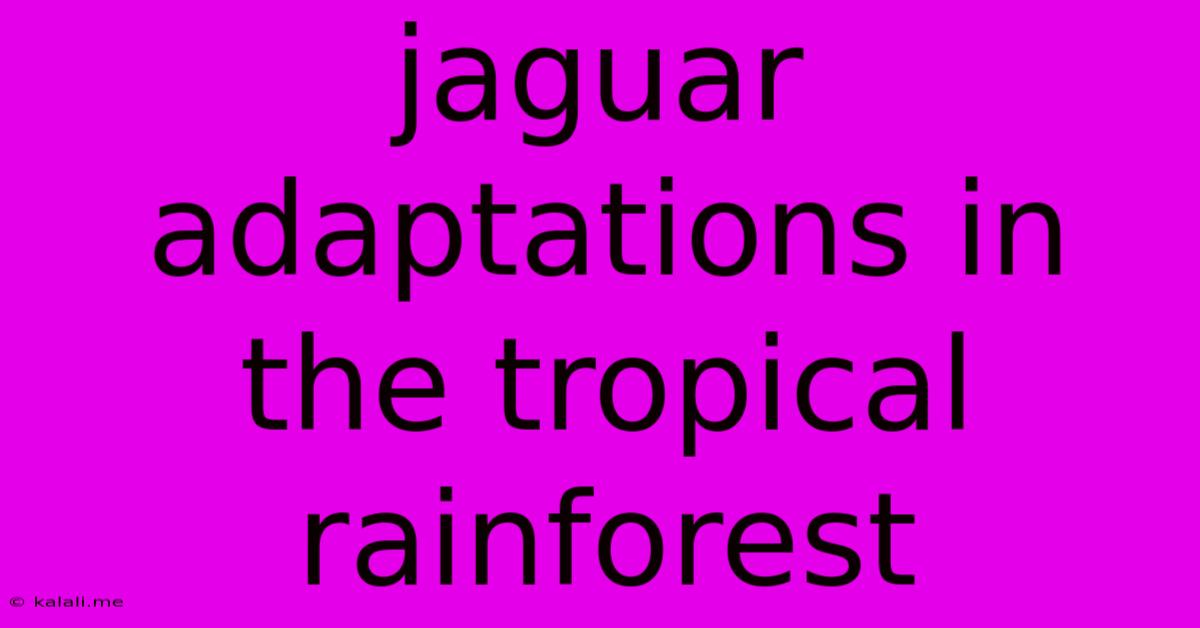Jaguar Adaptations In The Tropical Rainforest
Kalali
May 10, 2025 · 3 min read

Table of Contents
Jaguar Adaptations in the Tropical Rainforest: Masters of the Green Hell
The jaguar ( Panthera onca), the largest cat in the Americas, reigns supreme in the diverse and challenging environment of the tropical rainforest. Its survival hinges on a suite of remarkable physical and behavioral adaptations perfectly honed over millennia. This article delves into the key adaptations that allow this apex predator to thrive in this complex ecosystem, exploring its powerful build, sensory acuity, hunting prowess, and unique camouflage.
Physical Adaptations for Rainforest Survival:
The rainforest presents unique challenges, including dense vegetation, unpredictable terrain, and diverse prey. Jaguars have evolved a number of physical traits to overcome these obstacles:
-
Powerful Build and Musculature: Jaguars possess incredibly strong jaws and a robust body structure. Their muscular limbs and broad paws provide exceptional power for dragging prey through dense undergrowth. This strength is vital for taking down large prey, including capybaras, tapirs, and even caiman.
-
Specialized Teeth and Jaws: Their powerful jaws, equipped with exceptionally large canines and carnassial teeth, enable them to deliver a fatal bite, often targeting the skull or neck of their prey. They can crush bones with ease, a crucial adaptation for accessing the nutritious marrow within.
-
Short, Powerful Legs: Unlike their longer-legged cousins in open habitats, jaguars have relatively short legs, granting them agility and stability in the dense undergrowth. Their powerful legs allow them to quickly accelerate in short bursts for ambushes.
-
Excellent Swimmers: Jaguars are exceptional swimmers, an invaluable asset in the rainforest's many rivers and flooded areas. Their ability to swim allows them to hunt aquatic prey, such as caiman and fish, and easily navigate the flooded landscapes of the rainforest.
Sensory Adaptations: Hunting in the Shadows:
The low light conditions and dense vegetation of the rainforest demand exceptional sensory capabilities. Jaguars excel in this regard:
-
Acute Hearing and Sight: Their sensitive hearing helps them detect the slightest rustle in the undergrowth, crucial for pinpointing prey in dense vegetation. Their excellent night vision allows them to hunt effectively even in low light conditions.
-
Exceptional Sense of Smell: Jaguars rely heavily on their sense of smell to locate prey, track animals across distances, and navigate their territory. This heightened sense is vital in the complex olfactory landscape of the rainforest.
Behavioral Adaptations: Masters of Ambush:
Jaguars are ambush predators, relying on stealth and surprise rather than prolonged chases. Their hunting strategies are exquisitely adapted to the rainforest environment:
-
Solitary Hunters: Unlike some social cat species, jaguars are primarily solitary animals, reducing competition for resources in their expansive territories. This solitary lifestyle enhances their hunting success.
-
Ambush Predator Tactics: They patiently stalk their prey, using the dense vegetation for cover, before launching a swift and powerful attack. Their powerful bite ensures a quick kill, minimizing the chance of escape.
-
Dietary Flexibility: Jaguars demonstrate dietary flexibility, adapting their hunting strategies and prey selection according to the availability of resources. This adaptability is critical for their survival in the unpredictable rainforest environment.
-
Marking Territory: Jaguars meticulously mark their territory using scent and scratches, minimizing the chance of conflict with other jaguars.
Camouflage and Crypsis:
Jaguars possess a unique rosettes-patterned coat which provides effective camouflage in the dappled light of the rainforest understory. This cryptic coloration allows them to blend seamlessly into their surroundings, making them formidable and elusive predators.
Conclusion:
The jaguar's success in the tropical rainforest is a testament to the power of natural selection. Its physical and behavioral adaptations are finely tuned to the demands of this challenging environment, showcasing its incredible resilience and adaptability as the ultimate apex predator of the "Green Hell." The continued conservation of this magnificent species and its rainforest habitat is crucial to safeguarding the biodiversity of this vital ecosystem.
Latest Posts
Latest Posts
-
Courtesy Is Cumbersome To Them That Know It Not
Jul 02, 2025
-
How Far Is 220 Yards On A Track
Jul 02, 2025
-
What Is The Shortest Chapter In The Bible
Jul 02, 2025
-
What Has 4 Letters Sometimes Has 9
Jul 02, 2025
-
How Many Milliliters In A Half Gallon
Jul 02, 2025
Related Post
Thank you for visiting our website which covers about Jaguar Adaptations In The Tropical Rainforest . We hope the information provided has been useful to you. Feel free to contact us if you have any questions or need further assistance. See you next time and don't miss to bookmark.